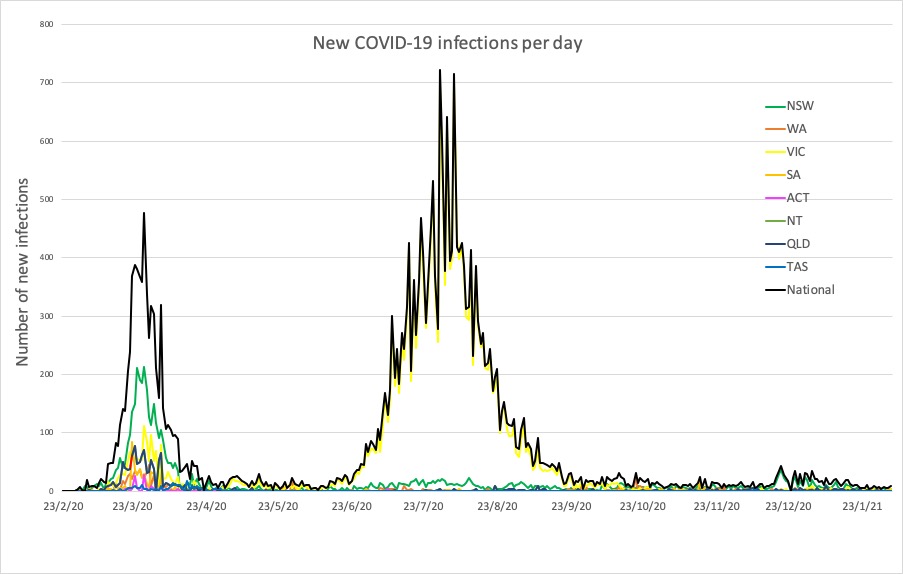And Australia expands definition of confirmed COVID-19 to include serological results.
Welcome to The Medical Republic’s COVID Catch-Up.
It’s the day’s COVID-19 news in one convenient post. Email bianca@biancanogrady.com with any tips, comments or feedback.
5 February
- Around half of COVID-19 transmission aboard the Diamond Princess likely to have been airborne, study suggests.
- Australian definition of confirmed COVID-19 expanded to include serological results.
- Individual social distancing adherence is associated with reduced COVID-19 risk.
- Nearly one in ten US marine recruits has had COVID-19.
- US vaccinates 13 million in first month of COVID-19 immunisation campaign.
- Latest confirmed COVID-19 infection numbers from around Australia.
Around half of COVID-19 transmission aboard the Diamond Princess cruise ship outbreak in March was likely due to airborne transmission, new research suggests.
A paper published in PNAS used detailed information about the outbreak to model a range of transmission scenarios over the course of the 35-day voyage which saw 712 of the 3,711 passengers and crew members infected on board and a further 57 diagnosed after they disembarked.
The start of the outbreak was traced to a single passenger who boarded in Hong Kong. Ten more cases were diagnosed a week later, which prompted a lockdown restricting all passengers to their cabins.
Researchers developed a variety of models of how the virus spread, examining close- and long-range transmission via large droplets, inhalation of smaller aerosols, and contact with contaminated surfaces, then looked at how well those models predicted the known spread of the virus throughout the ship.
They found that airborne transmission via small aerosolised particles containing the virus was most likely the dominant mode of transmission, even accounting for high ventilation rate and low levels of air recirculation.
They concluded that long-range and short-range transmission were about equal in their contribution to infections, but “aerosol transmission across both short- and long-range distances accounted for >50% of disease transmission overall, which is contrary to the prevailing positions on how COVID-19 is spread held by organizations like WHO and CDC, but is consistent with emerging evidence for airborne transmission.”
The authors suggested their modelling could be applicable to other indoor environments … say, for example, quarantine hotels?
The criteria for a confirmed case of COVID-19 in Australia has now been updated to include antibody levels, according to new information from the Communicable Diseases Network Australia.
The new criteria – which adds to existing criteria of a positive RT-PCR test or nucleic acid test – recognises a positive result where SARS-CoV-2 IgG or neutralising antibodies are either present or numbers have increased at least four-fold, in the absence of recent COVID-19 vaccination.
Do you move away from others on the footpath, or choose a less crowded path to walk through an area? Research suggests that these individual decisions about physical distancing are associated with a significantly lower likelihood of getting COVID-19.
A paper published in PNAS took an individual-level look at the impact of social distancing measures by surveying 2,120 individuals firstly about their self-reported distancing behaviours but also presenting them with ten different virtual scenarios and exploring how they would respond. Four months after the survey, respondents were contacted again to ask about whether they had contracted COVID-19.
The scenarios included presenting an aerial image of a crowded beach and asked people to click on the spot where they would lay down their towel; choosing how many people they would feel comfortable having in a grocery store with them; how much distance they would want between them and others standing in line, and how close they would stand to a friend while out on a walk.
The results found that the more likely individuals were to practice social distancing, the less likely they were to contract COVID-19. There was a clear dose-response relationship such that an increase of one standard deviation on the virtual behaviour measure of social distancing was associated with around a 20% reduction in the odds of getting COVID-19.
“The relation was apparent without aggregation across large numbers of people residing in a given locale—a characteristic of much of the research that has examined social distancing as a mitigating factor in the spread of the virus,” the authors wrote. “In this respect, the current findings offer a unique form of additional evidence as to why individuals should indeed practice social distancing.”
Nearly one in ten recruits to the US marines has been found to be seropositive for SARS-CoV-2, according to a paper published in Emerging Infectious Diseases.
A study of 3,249 volunteers, who were in quarantine before beginning their training, found 9% carried SARS-CoV-2 antibodies and nearly 1% tested positive on RT-PCR.
However among Hispanic recruits, the seropositivity rate was 17% and among Black recruits it was 15%.
In the first month of its COVID-19 vaccination campaign, the US has vaccinated around 13 million individuals – around 4% of the population – 63% of whom were women, 55% were aged 50 or older, and 60% were white, according to a report in Morbidity and Mortality Weekly Report.
On day 5 of Western Australia’s lockdown, there’s still no sign that the single case of SARS-CoV-2 detected in a quarantine hotel security guard has spread any further. However the state’s health authorities are still encouraging anyone with symptoms to get tested, and has updated the list of locations that the infected guard visited before being tested.
Here are the latest confirmed COVID-19 infection numbers from around Australia to 3pm Thursday:
National – 28,838 with 909 deaths
ACT – 118 (0)
NSW – 5117 (3)
NT – 99 (1)
QLD – 1311 (0)
SA – 601 (0)
TAS – 234 (0)
VIC – 20,452 (3)
WA – 906 (2)



